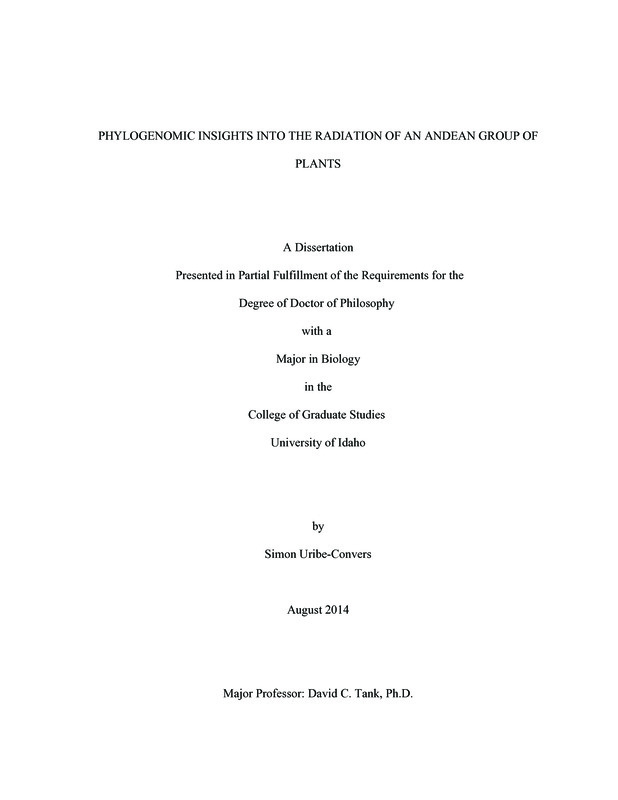Phylogenomic Insights into the Radiation of an Andean Group of Plants
Uribe Convers, Simon. (2014). Phylogenomic Insights into the Radiation of an Andean Group of Plants. Theses and Dissertations Collection, University of Idaho Library Digital Collections. https://www.lib.uidaho.edu/digital/etd/items/uribeconvers_idaho_0089e_10193.html
- Title:
- Phylogenomic Insights into the Radiation of an Andean Group of Plants
- Author:
- Uribe Convers, Simon
- Date:
- 2014
- Keywords:
- Bartsia Evolution Genomics Neobartsia Phylogenetics Systematics
- Program:
- Biology
- Subject Category:
- Biology; Evolution & development; Systematic biology
- Abstract:
-
This dissertation focuses on the evolutionary history of the Neobartsia clade of the plant genus Bartsia (Orobanchaceae) distributed throughout the high elevation páramo ecosystem in the Andes. This group of plants was the subject of a detailed taxonomic study in the 1990's, as well as various phylogenetic studies at higher taxonomic levels. However, the work presented in this dissertation constitutes the most comprehensive study of the group so far. I conducted extensive fieldwork throughout the Andes and was able to sample every species described to date, including multiple individuals per species for many, and I have used these collections to elucidate phylogenetic relationships among closely related genera, and between the ~45 species in the clade. My molecular systematic work was accompanied by comparative phylogenetic studies focused on the time of divergence, historical biogeography, and the rate of diversification of the group, which showed that the clade is the result of an ongoing recent and rapid radiation that began ~3 million years ago - a time period when the northern Andes had the necessary elevation to generate alpine conditions.
It was clear from these studies, that the genetic diversity within Neobartsia was low, given the young age of the genus, and therefore, I began to focus on developing genomic approaches to generate large amounts of phylogenetic data, both efficiently and cost effectively. This last part of my dissertation resulted in two genomic methods being developed, one for sequencing complete chloroplast genomes, and one for generating targeted subgenomic datasets, which were used to generate the data necessary to elucidate interspecific relationships. Finally, I revised the taxonomy of the clade and its closely allied genera to reflect these phylogenetic results, alleviating a history of taxonomic instability by elevating the South American Bartsia clade to the newly formed genus Neobartsia, thereby recognizing its unique evolutionary history.
- Description:
- doctoral, Ph.D., Biology -- University of Idaho - College of Graduate Studies, 2014
- Major Professor:
- Tank, David C
- Committee:
- Sullivan, Jack M; Harmon, Luke J; Roalson, Eric H
- Defense Date:
- 2014
- Identifier:
- UribeConvers_idaho_0089E_10193
- Type:
- Text
- Format Original:
- Format:
- application/pdf
- Rights:
- In Copyright - Educational Use Permitted. For more information, please contact University of Idaho Library Special Collections and Archives Department at libspec@uidaho.edu.
- Standardized Rights:
- http://rightsstatements.org/vocab/InC-EDU/1.0/

